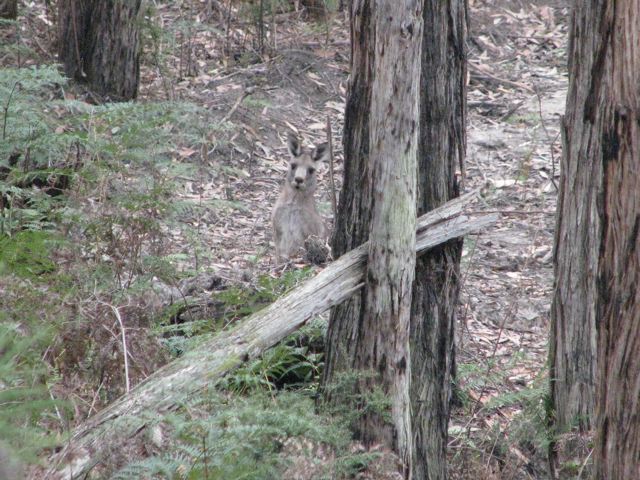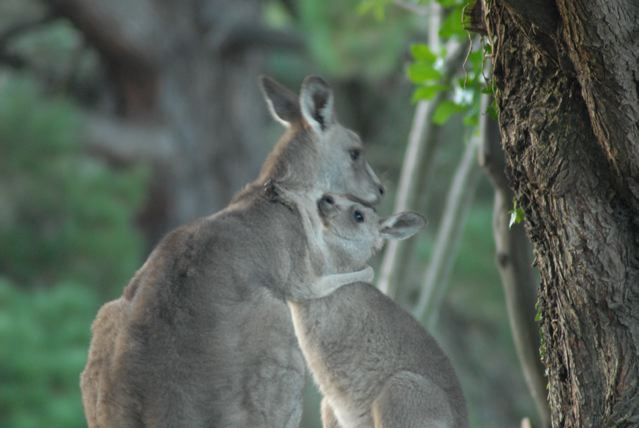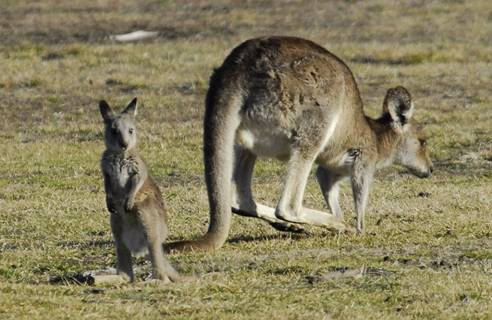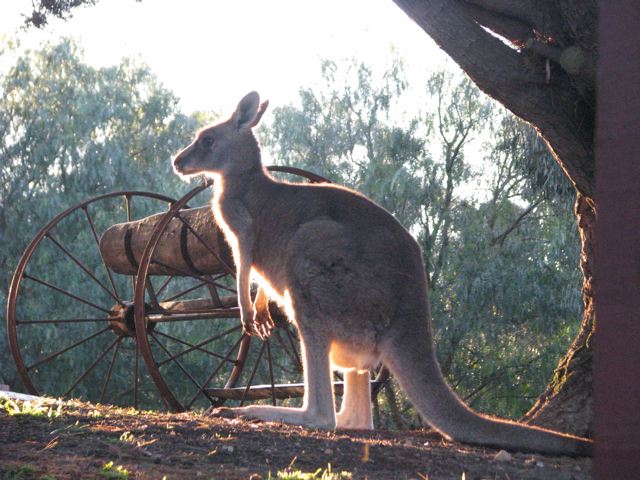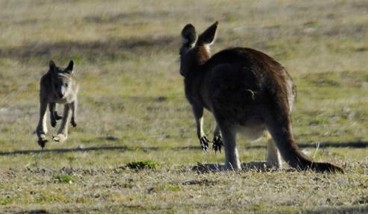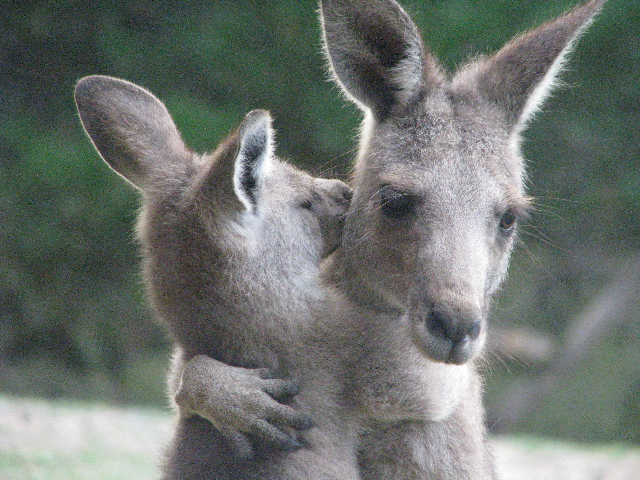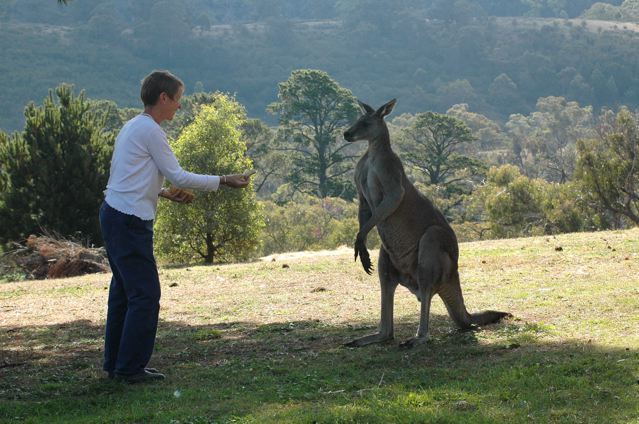Kangaroos
are commercially hunted across New South Wales, Queensland, South
Australia and Western Australia. They are sold as pet food and leather.
Their skins are sold to international shoe companies such as Adidas,
Nike, Reebok, Puma, Florsheim and various other European and American
shoe manufacturers.
The Federal
Government is responsible for monitoring the industry in the commercial
hunting states, and is bound by the Environmental Protection
Biodiversity and Conservation Act 1999, to ensure the protection of
biodiversity and native species. Tragically however the Federal and
state governments have failed to protect kangaroos, with government
data exposing a commercial trade in leather and meat, combined with
severe drought, decimating kangaroos to the edge of extinction across
most New South Wales, Queensland and South Australia.
Red Kangaroos, Western and Eastern Grey Kangaroos, Wallaroos and Euros,
have been hunted to critical levels of less than five kangaroos per
square
kilometer (5k/km
2), densities defined by the
Murray Darling Report as 'quasi extinction' and meaning:-
"The nominal value of kangaroo
densities taken to indicate the effective loss of the species(1)
."
The
Murray Darling Report is a scientific report published by the Murray
Darling Commission and written by government and independent
scientists. It makes clear warnings regarding the risks of hunting
kangaroos below 5k/km
2 ('quasi
extinction'):-
"Strategies
that produce average densities of less than 5 kangaroos per square
kilometer would result in minimum densities of less than 2 kangaroos
per square kilometer, and could be considered a threat to species
conservation(2)."
As
stated earlier, all commercially hunted kangaroos are
now quasi
extinct across most of New South Wales, Queensland and South
Australia, and as predicted by the Murray Darling Report, kangaroo
numbers have crashed even further to less than two per square kilometer
across half of these states:-
"Critical
minimum densities are not clearly defined but populations below 2
kangaroos per square kilometer would generally be considered at risk of
extinction(3)."
Photo
by Stella Reid
SOUTH
AUSTRALIA
The
commercial hunting zones cover most of South Australia. There are
almost no areas in South Australia where kangaroos are fully protected.
Three kangaroo species are commercially hunted for their meat and skin
in South Australia - Red Kangaroos, Western Grey Kangaroos and Euros.
Population counts for 2007 show Red and Western Grey Kangaroos at their
lowest level ever recorded.
Across most
of South Australia all three commercially hunted species
are quasi
extinct. Despite these critical levels, the South Australian
Government has set a quota of 12-20% to be killed by the kangaroo
industry between now and 2012 when the Kangaroo Management Plan (KMP)
is reviewed.
S.A. Red
Kangaroo
* Red Kangaroos are at
their lowest level ever recorded in South Australia.
* Red Kangaroos are quasi extinct across 92% of South
Australia, and at less than 2k/km2 across
50% of the state.
* Since 1998, across 42% of South Australia, up to 80% of Red Kangaroos
have been lost.
* Despite Red Kangaroos being at their lowest evel ever, the kangaroo
industry will slaughter 192,000 in 2008 alone.
* Red Kangaroos only grow at a rate of 6-8% per year. Therefore they
are being killed at a rate three times faster than they can breed(4).
The
commercial quota is the percentage of the population killed by the
commercial kangaroo industry every year.
For 2008 this stands at 3.6 million kangaroos. This quota does not
include pouch joeys killed by the shooter, ex pouch
joeys orphaned and left to die, kangaroos killed privately by farmers,
kangaroos killed by local governments in National Parks and State
forests, kangaroos killed illegally, kangaroos killed on the road or
those who perish in drought, flood and bush fires, or when their
habitat is destroyed by development. The total annual toll on kangaroos
is probably in excess of double the commercial quota.
S.A. Western Grey
* Western Grey Kangaroos
are at their lowest level ever recorded in South Australia.
* Western Grey Kangaroos are quasi extinct across 80%
South Australia, and are at less than 2k/km2
across 60% of South Australia.
* Since 1997 Western Grey Kangaroos have crashed by 72-80% across 42%
of the state.
* The kangaroo industry will kill 76,000 Western Grey Kangaroos in
South Australia in 2008, despite being at their lowest level ever
recorded.
Euros
* Euros are quasi
extinct across most of South Australia, and at densities of less than
2k/km2 across 63% of the state.
* Despite this, the kangaroo industry will kill 59,000 Euros in South
Australia in 2008 alone.
*
Across half of South Australia 50% of the kangaroos killed by the
commercial industry are female. Killing 50% females from a wild
population puts a species at great risk of extinction.
* The average
weight of kangaroos killed by the commercial industry in South
Australia is just 22kg. These kangaroos are therefore only 18 - 36
months old and barely of breeding age. Kangaroos can
weigh up
to 90kg and live for 25 years.
'Research
shows that the average age of Red Kangaroos is now only 2 years old(5).'
This provides evidence to support the theory that the big kangaroos
have been wiped out by the industry for their larger skins, and with
few kangaroos left, the industry is forced to kill more females, and
smaller, younger kangarooos which are the breeding stock for the
future; a certain recipe for extinction.
The ongoing killing of the large males
also creates a genetic disaster,
weakening their genetic and physiological strength, leaving them unable
to cope in
drought and disease. This, combined with the loss of critical mass that
we are witnessing now, has the potential to wipe out the species.
'Removing the alpha males from a
mob also destroys social order, leaving
females at the whim of younger and immature males and a mob with no
structure or hierarchy. This is a dangerous and potentially fatal
situation for the doe (female) and any joey she may have in pouch or at
foot. It can lead to the death of the doe and her joeys from stress
myopathy or exhaustion as she desperately tries to escape the forceful
advances of the young males. The larger dominant males also play a role
in integrating with the young joeys, playing with them from a very
young age, and teaching them all the important survival
techniques.'(33)
All the above data regarding South Australia's kangaroo populations and
'harvest' statistics were obtained this year (2008) from Dana Thomson,
Ecologist-Kangaroo Management, South Australian Department of
Environment and Heritage
(6).
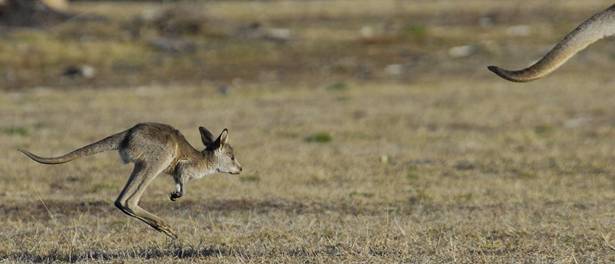 Photo
by Ray Drew
Photo
by Ray Drew
QUEENSLAND
The
commercial kangaroo industry has access to 94% of the state, leaving
only 6% of Queensland protected habitat for kangaroos. Queensland Red
Kangaroos, Eastern Grey Kangaroos and Wallaroos are killed at a rate of
10-20% of the population each year by the commercial kangaroo industry
alone.
Qld Red Kangaroo
* Red Kangaroos
are quasi extinct across 70% of Queensland, and at densities
of less than 1.6 k/km2 across 40% of the
state.
*
Despite these critically low levels the Queensland Government has
allowed the kangaroo industry to kill 608,408 of the remaining Red
Kangaroos in Queensland in 2008 alone.
Qld Eastern Grey Kangaroo
* Since
2001 Eastern Grey Kangaroo populations have crashed by 45% in
some areas and up to 90% in others across 62% of the
state.
* Eastern Grey Kangaroos are quasi extinct across 36% of
Queensland.
* The kangaroo industry will kill 1,013,203 of the remaining Eastern
Grey Kangaroos in Queensand in 2008.
Wallaroos
* Wallaroos
are quasi extinct across 86% of Queensland, and at densities
of less
than 2k/km2 across 52% of the state.
* Numbers of Wallaroos in Queensland have crashed by up to 99% in some
areas.
*
Despite these figures, the commercial industry will 328,060 of the
remaining Wallaroos in Queensland in 2008 alone.
*
As in South Australia, the average weight of kangaroos killed by the
kangaroo industry in Queensland is just 20kg. These kangaroos are
barely of breeding age.
All Queensland data relating to population densities was obtained
from the Queensland Environmental Protection Agency, Macropod
Management Unit
7).
Photo by Stella Reid, Wildhaven
NEW SOUTH WALES
The
commercial kangaroo management zone takes up 85% of NSW, leaving just
15% of the State as protected habitat for kangaroos under the National
Parks and Wildlife Act Pt 4.
N.S.W Red Kangaroos
* Red
Kangaroos are at densities of less than 3.3 k/km2 across
68% of their range in NSW.
* Red Kangaroos are at their lowest level ever recorded across 40% of
their range in NSW.
* Red Kangaroo numbers have been decimated by 50% across 85% of NSW.
*
The commercial industry will slaughter 429,156 of the remaining Red
Kangaroos in NSW in 2008 for export as leather and meat.
N.S.W Eastern Grey
Kangaroos
* Eastern Grey Kangaroos
are at their lowest level ever recorded across 27% of the commercial
killing zone.s
* Eastern Grey Kangaroos are at densities of less than 5 k/km2 across
36% of the commercial killing zones.
* Eastern Grey Kangaroos have been decimated by 50% across 85% of NSW.
*
The Kangaroo Industry will slaughter 600,000 of the remaining Eastern
Grey Kangaroos in 2008.
Wallaroos
* Wallaroos
have been decimated by 63% and are quasi extinct (less than 3
k/km2) across
the entire killing zone of NSW.
* Wallaroos are at their lowest level ever recorded in NSW.
*
Despite this catastrophic situation, the NSW government has set the
quotas for Wallaroos at their highest level ever, allowing the
commercial kangaroo industry to slaughter 17,245 of the remaining
Wallaroo
population in 2008.
All data above was taken from the NSW Kangaroo Management Program -
Quota Report for 2008, NSW Department of Environment and
Conservation
(8).
Photo by Ray Drew
THE
FOLLOWING INFORMATION EXPOSES CENTURIES OF PROPOGANDA AND MYTH THAT HAS
FALSELY JUSTIFIED THE WORLD'S LARGEST WILDLIFE SLAUGHTER AND SENT AN
AUSTRALIAN ICON TO THE BRINK OF EXTINCTION.
For
decades the Australian and State governments have assured the public
that the commercial slaughter of our national icon is necessary to
control kangaroo numbers, protect farmers, is economically and
environmentally sustainable and poses no threat to kangaroo
conservation. The information and scientific reports discussed here
expose a
commercial trade in kangaroos that is not only unnecessary and
unsustainable, but is in breach of the Environmental Protection and
Biodiversity Conservation Act 1999.
The
Murray Darling Report, titled ‘Kangaroo Options in the Murray Darling
Basin’ was written in 2004 by Ron Hacker, Steven McLeod, John Duncan,
Brigitte Tenhumberg and Udai Prahan. It clearly states that:-
'Harvesting
over most of the region ceases to be economically viable at densities
considerably higher than those commonly regarded as minimum levels for
conservation (5k/ km2)'(9).
'Reduction
of kangaroo densities to less than 5 kangaroos per square kilometer
over large areas would result in the demise of the kangaroo industry'(10).
'Pastoralists
would need to accept that reduction of kangaroos to very low densities
(<5k/km2) over large areas is neither
commercially feasible, ecologically defensible or economically
justified'(10).
So
the Australian government is not only allowing a commercial wildlife
trade to slaughter kangaroos in areas where they are at risk of
extinction, but is supporting an industry that is unsustainable,
destroying kangaroos faster than they can breed.
A literature review prepared for the Kangaroo Management Advisory Panel
in March 2006, by the School of Botany and Zoology, Australian National
University, ACT, titled ‘Situation Analysis Report, Update on
Current State of Scientific Knowledge on Kangaroos in the Environment,
Including Ecological and Economic Impact and Effect of Culling’ by
Penny Olsen and Tim Low, confirms the findings of the Murray Darling
Report in its executive summary:-
'Evidence
suggests that commercial harvesting is not sustainable at densities
that threaten any of the harvested species with extinction'(11).
'The Australian State of the Environment Report 2006' found that:
'At present there are
insufficient data available on actual kangaroo
populations and characteristics to demonstrate that harvesting does not
have a detrimental impact on either the harvested species or their
ecosystem'(12).'
In
evidence given at the NSW Administrative Appeals Tribunal (A.A.T.)
court proceedings, Wildlife Protection Association Australia
(Applicants) vs NSW Minister for Environment Heritage and the Arts
(Respondent), No. N535 of 2007, it was found that within the 2008-2012
NSW Kangaroo Management Plan, there are no “trigger levels” with which
to identify when the kangaroo population was at risk. Therefore the
current quotas would continue, despite critical densities, until 2012
when the current KMP expired. The applicants argued
that:-
'None
of the Actions of the Plan provided for the suspension or reduction of
the commercial killing of kangaroos if certain threshold situations are
reached. There is no specific level of detriment or harm above which
the Plan is suspended or the quotas are reduced'(13)
'The
Environmental Protection & Biodiversity Conservation (EPBC) Act
requires the Management Plan include management controls to ensure that
‘the
impacts of the activities’ on each of the species of kangaroos are
ecologically sustainable, and that on the evidence the Tribunal cannot
be satisfied that there are sufficient management controls included in
the Plan that ensure the impacts are ecologically sustainable'(14).
'Ecological
sustainability requires some benefit of the use. The Plan cannot be
shown to produce any conservation or biodiversity benefit. Killing part
of the population is not necessary for the survival of the rest of the
population of the species'(15).
It
is also important to note what was heard from the Minister for
Environment Heritage and the Arts (Respondent) during the hearing:-
'The
respondent accepted that a quota of 17% per annum and the addition of
the special quota would be unsustainable in the long- term'(16).
An equally disturbing report written by Dr Mark Drummond warns of these
predictions:
'According to the least squares exponential regression equation
established using Eastern Grey Kangaroo population estimates provided
by the Australian Government Department of the Environment, Water,
Heritage and the Arts for the period 2001 to 2007, the number of
Eastern Grey kangaroos in Australia will reduce from 30 million in 2001
and 10 million in 2007 to about 5 million in 2010, 2 million in 2015
and less than 1.0 million in 2020 if the trend observed from 2001 to
2007 continues until 2020.' (34)
In
light of these statistics, the fact that all four species have already
crashed by 50% in some areas and up to 70% in others between 2001 and
2007 alone, and the large scale quasi extinctions across three
out of the four commercial hunting
states, along with the real and pending threat of further drought,
fire, flood, lack of habitat, water and food across Australia, it is
highly likely that if the commercial and non-commercial killing of
kangaroos continues in New South Wales, Queensland and South Australia,
there would be large scale irreversible extinctions of Red Kangaroos,
Eastern and Western Grey Kangaroos, Wallaroos and Euros across three
states within just a few years.
These
statistics also expose a significant breach of the Environmental
Protection and Biodiversity Conservation Act by the Australian
Government and the Kangaroo Industry Association Australia, whereby
they have failed to protect kangaroos at the extent of their range and
ensure that the impacts of the industry are ecologically sustainable.
It has also failed in other aspects of the EPBC Act by inflicting
significant cruelty on pouch joeys and ex pouch joeys in the manner in
which they are dispatched (bashed/stomped to death, decapitated, and/or
orphaned and left to die from starvation, predation, stress and
exposure), therefore failing to 'protect the humane treatment of
wildlife' and by not taking a 'precautionary principle when making
decisions relating to the utilization of wildlife'
(17).
'The
shot to the head out of the darkness that the industry and its
supporters promote as clean, green and humane; every night leaves
behind abandoned young-at-foot quietly coughing in an attempt to unite
with their mothers - but nobody hears.' (35)
Scientific evidence now available
exposes a large scale slaughter of
'protected' native animals, the world’s largest wildlife massacre,
based
on propaganda and myth, promoted by a cruel and unsustainable trade in
a precious Australian icon.
Government
and independent scientists such as the CSIRO, Prof. Gordon Grigg
(Environment Australia), Steven McLeod (University of NSW, NSW Dept
Primary Industries), Dr Tony Pople, Penny Olsen and Tim Low (School of
Botany and Zoology, Australian National University, Canberra ACT) Dr
David Croft (Fowlers Gap Research Station School of Biological, Earth
and Environmental Sciences, University of NSW) and Ingrid Witte (NSW
Dept Environment
and Climate Change, University of NSW) now agree that based on the
evidence, kangaroos exert negligible impact on pastoral and agriculture
production, hence undermining the justification for this large scale
destruction of unique native animals.
Ms Nicole
Payne, Manager of Kangaroo Management Program, NSW Department of
Environment and Conservation, admits in the Administrative Appeals
Tribunal that the commercial slaughter of kangaroos is;-
'Not designed to achieve
population control or damage mitigation, but for commercial harvesting'(18).
Ms
Payne also agreed with Olsen and Low (2006) in their Literature Review
‘Update on Current State of Scientific Knowledge on Kangaroos in the
Environment, Including Ecological Impact and Economic Impact and Effect
of Culling’ that:-
'Damage
mitigation as grounds for harvesting is unfounded'
'Kangaroos
provide some benefits to biodiversity and, save for exceptional
circumstances, are not competitors with sheep or cattle'(19).
Pople
and McLeod (2000, UNSW) are also referred to in the court proceedings
as well as Olsen and Brayshaw (2000), and support the overriding
evidence that between sheep and kangaroos:-
'Competition seldom occurs'(20).
Within Olsen and Low’s Literature Review, they also confirm these
findings;-
'Indeed
there is little convincing evidence of substantial damage by kangaroos
to crops, pastoral production or rangelands, except in a few localized
areas'(21).
Grigg
(2002) proposed that kangaroos had a DSE (dry sheep equivalent) of just
0.2, meaning that kangaroos consume only one fifth that of sheep. He
states:-
'The
removal of kangaroos will not bring expected benefits to woolgrowers in
part because kangaroos are a much smaller component of total grazing
pressure than is generally assumed'(22).
‘The Australian State of the Environment Report’
supports these studies in its findings, that of the 60% of Australia
that is made up of low intensity grazing land, kangaroos exert a
grazing pressure of just 1-8%, compared to sheep and cattle who
combined exert a grazing pressure of 92-99%.
(23)
Photo By Stella
Reid, Wildhaven
Dr David Croft, in his paper ‘The Future of Kangaroos:
Going Going Gone?
disputes claims that kangaroos take advantage of ‘rested’ paddocks and
inflict damage:-
'Grazing
pressure in the de-stocked paddocks had in effect significantly been
reduced by the removal of 400 sheep. The amount of kangaroo dung never
surpassed that of kangaroos in the stocked paddock, despite the absence
of sheep.'
'Given the sedentary behaviour of
mature individuals, there is no strong evidence that Red Kangaroos
invade areas of improved pasture within a short period of time and
remain there to cause long term damage.'(24)
In fact, further research from Fowlers Gap Research Station
reported a positive relationship between the biomass of both total
pasture and green pasture and kangaroo density. Witte states that these
findings support the conclusion that kangaroos and livestock do not
compete strongly for food (at least in the rangelands), that resource
availability drives the grazing systems and that:-
'Mixed species grazing regimes
are more productive and ecologically sound'(25)
Olsen and Brayshaw (2003) agree;-
'Kangaroos
do not appear to impact greatly on wool production and mixed grazing
systems (cattle and kangaroos/sheep and kangaroos) tend to be most
productive'(27).
The CSIRO conducted extensive research on the competition between
kangaroos and sheep in terms and found that:
'
The authors conclude that
competition between sheep and kangaroos is small'
(26).
Literature
written by ecologist Dan Ramp (University of NSW) such as his
paper "Our ‘Common’ Wildlife May Be the Next ‘Sleeping’
Threatened Species" describes the importance of kangaroos in protecting
threatened and endangered species from decline:-
'Native
herbivores such as kangaroos and wombats, play a vital role in
ecosystem functioning but are often victimized and treated with lack of
concern because of socio-political factors and historical value
judgements rather than heeding biological and ecological information.' (28)
He also refers to the findings of Smith and Knapp (2003):-
'It
is widely recognized that species and ecosystem function are strongly
linked. Common species can play key roles in conferring short-term
resistance to reductions in ecosystem functions, as rare and uncommon
species are lost from the system. We now have entered earth’s
sixth mass extinction event, this time human driven, and yet the
setting aside of protected areas may not be sufficient to prevent this
loss of biodiversity…little research has rigorously quantified
implications for biodiversity at local scales. Many species that are
now considered common will be affected, but unless we target those
‘sleeper’ species through monitoring of their distributions and
functioning in ecosystems, managers will only be able to be reactive to
declines, rather than proactively preventing them.'(28)
David
Croft challenges the myth that there are more kangaroos now than before
white settlement, which is another unfounded argument used to justify
decades of decimation of kangaroos across Australia:-
'The contention that there have
never been so many kangaroos in Australia until the advent of farming
and pastoralism is an absurdity. Firstly, in
the first several million years of occupancy of the Australian
continent by the modern kangaroo fauna, who has the time machine to
know?' (How
many kangaroos there were
pre-colonisation). (29)
When calculating the country’s
ability to support sheep and cattle in present day conditions, Croft
equates the land’s ability to support the 2004 estimates of sheep and
cattle at 22 million cattle and 105 million sheep, or 237 million Dry
Sheep Equivalent. This is equivalent to the energy demands of 339
million to 1.185 billion kangaroos (at just 0.2 - 0.7 DSE). The
kangaroo population has been estimated at just 20 million in recent
years and therefore:-
'Amazingly
we have been clever enough to create pasture for the equivalent 7-24
times the more generous estimate of the number of kangaroos currently
in Australia yet this supposedly excessive number was unsustainable
pre-1788'(36).
In regard to the myths that man-made water sources have increased
kangaroo populations, Croft believes:-
'This
same landscape is populated with a vast network of drainage channels,
ephemeral creeks, gilgais and clay pans. All of these can hold water
for weeks to many months after a very modest rain.'(30)
'If
you make the effort to observe the behaviour of kangaroos in the arid
rangelands, as I have done for over 29 years, they will show that any
water source, no matter how small and fetid, is acceptable and usable.'
(30)
He believes that not all their water requirements are required from
drinking water as such and:-
'Water taken in with plant
matter and created with oxidation of foodstuffs both add to the water
budget.'(30)
Croft also refers to a statement by John Calaby who once supported the
interpretation that Red Kangaroos have increased since white
settlement:-
'Red Kangaroos are not nearly so
abundant as is generally thought and that they are subject to great and
sudden decline in numbers due both to overshooting and to drought;
where both occur together there seems to be a very real chance that the
species could be reduced to a level from which it cannot recover.' (37)
Dr John Auty in his paper 'Red Plague Grey Plague'
also challenges the myth that there are more kangaroos now than before
European settlement. In his paper he refers to a multitude of
historical records and documents:-
'At first white settlement,
kangaroos were widely distributed in large numbers.'
'The CI
Dingo was a poor predator on kangaroos and for this reason was not used
by Aborigines in hunting them.'
'The
numbers of kangaroos present in Australia at the time of first European
settlement can be estimated on the basis on the number of introduced
herbivores supported on unimproved pasture and browse. The population
was probably of the order of one to two hundred million.'(31) (Ten
times more than the current estimated
population).
In
regard to the principles of the commercial utilization of wildlife, in
particular kangaroos, it is important to note that while the commercial
Kangaroo Industry is worth $200 million annually, there are few who
benefit from these profits, while the Australian community loses its
most valuable environmental and tourist draw card. Tourism is
worth over $85 billion dollars annually to Australia, and with our
native wildlife being one of the main attractions for international
tourists, kangaroos are worth more to us alive than dead.
According to a recent survey,
the kangaroo image was the second most recognized symbol in the world,
second only to the Statue of Liberty. As part of the same survey,
international tourists were polled at Sydney airport, and it was found
that half the international tourists wanted to see kangaroos or other
wildlife as part of the visit. One quarter reported they had not seen
the kangaroos they wanted to see during their visit.
(32)
The kangaroo industry and the Australian government is decimating our
tourist icon for just $1 kilo for its meat, and around $6 for its skin.
Tourism is worth four hundred and twenty five times the value of the
industry that is decimating one of Australia's most significant tourist
attractions.
photo by Ray Drew
David Croft (UNSW, 2005) wrote in regard to kangaroos and tourism:
'Thus
at times of good and frequent rainfall there will be a build up of the
population just like the bounty of the ephemeral plants that they eat.
We should marvel at this great wildlife spectacle and carry planeloads
of tourists to the Outback just like those few occasions when the Lake
Eyre basins fills with water and waterfowl. There is no greater sight
than red backs bent into a sea of wildflowers with the young leaping
and finding their full hopping stride as they cavort around their
mothers. If it were the Adoni plain of Etosha National Park or the Auob
River of the Kgalagadi Transfrontier Park of Southern Africa and the
sprinbok calves were pronking, it would be a wildlife spectacle. In
Australia it's just a plague of bloody kangaroos.' (38)
Photo by Stella Reid
Professor
Steve Garlick, (Sunshine Coast University, Qld) has spent the last nine
years rescuing and rehabilitating kangaroos and had this to say about
the importance of saving them:
"If
you ever have the wonderful opportunity, while alone, of being close
and spending quiet time with a wild animal you will find the soul
uplifted to heights of awareness not ordinarily experienced. Beyond the
simple biological and biophysical, you will discover skills, knowledge
and behaviour we humans rarely recognise but can learn much from to
help us in an increasingly tortuous world. Sharing some of your life
with kangaroos is particularly rewarding. Kangaroos are gentle,
affectionate and family-oriented creatures with relational
characteristics that respond well to human kindness. There is much that
can benefit the basic requirements of a decent human society by closely
observing the kangaroo in its environment. You will find no dishonesty
or deceit and, if you are in a relational ethic with them, they will
let you know whether they are prepared to trust you. At a practical
scale you will discover incredible navigation skills that humans are
forced to copy, not learn, through the application of technology. In
the end, being cruel to kangaroos and our other unique wildlife, or
treating them as just an object to be counted and then discounted means
we lose an opportunity to learn and gain an awareness of ourselves that
may prove crucial for our own very existence." (39)
In
light of current statistics and dire forecasts, it is clear that the
kangaroo industry is unsustainable, with the industry now reduced to
killing kangaroos barely of breeding age, at a rate faster than they
can breed. If we were to refer only to the scientific information
within this document, we could safely say that the kangaroo industry is
in decline, taking our precious national symbol down with it and
destroying one of our main assets and, most profitable industries, the
Australian Tourism Industry.
Summary
Since
1980, 73 million kangaroos have been killed by the Kangaroo Industry
and turned into pet food and sports shoes. Around 14 million pouch
joeys have been bashed to death or decapitated and 7 million young at
foot joeys have been orphaned, and left to die a slow and lonely death
from stress, starvation, and exposure. This combined with years of
intense drought, floods and bush fires, has seen Red Kangaroos, Western
Grey Kangaroos, Eastern Grey Kangaroos, Wallaroos and Euros plummet to
densities of less than 5k/km
2
(quasi extinct) across
most of Queensland, New South Wales and South Australia. These species
are now at risk of extinction in these states, and if the commercial
industry is allowed to continue, scientific forecasts predict mass
extinctions of Red, Western and Eastern Grey Kangaroos, Wallaroos and
Euros, across most of New South Wales, Queensland and South Australia.
We therefore make an urgent request that the Australian Government
impose an immediate moratorium on the commercial and non-commercial
slaughter of kangaroos across New South Wales, South Australia and
Queensland for the sake of our country, for the sake of our
environment, for the sake of our economy, for the sake of our
reputation, and for the sake of our Icon.
Now, more than ever before,
it’s time to stop killing kangaroos.
Photo by Stella
Reid
REFERENCES
1.
Hacker R, McLeod S, Drunan J, Tenhumberg B, Prahan U, (2004),
'Kangaroo Options in the Murray Darling Basin,' Murray Darling
Commission, NSW Agriculture, Canberra, ACT, p.62
http://publication.mdbc.gov.au/product_info.php?products_id=148
2. Hacker et al, 2004, p.51
3. Hacker et al, 2004, p.47
4. Bilton, Amanda 2000, University of NSW
5. Rowe S, (2005) 'Kangaroo Myths and Realities,' (Australian Wildlife
Protection Council, Melbourne, Vic), p.104
6.
Thomsen Dana, 2008, Ecologist - Kangaroo Management, Dept
Environment and Heritage (South Australia’s kangaroo populations and
'harvest' statistics data)
7. Lundie-Jenkins G, (2008), Raw Data, Queensland Environment
Protection Agency, Macropod Management Unit
8. Payne N, (2007) '2008 Kangaroo Quota Report New South
Wales' NSW Dept
Environment and Conservation, North West branch
www.environment.nsw.gov.au/resources/nature/2008KangarooQuota.pdf
9. Hacker et al, 2004, p.57
10. Hacker et al, 2004, p.63
11.
Olsen P, and Low T, (2006), 'Update on Current State of Scientific
Knowledge on Kangaroos in the Environment, Including Ecological and
Economic Impact and Effect of Culling' School of Botany and
Zoology, Australia National University, Canberra, ACT, p.7
12. Beeton
R.J.S., Buckley K, Jones G, Morgan D, Reicht R.E., Trewin D, (2006)
'Australian
State of the Environment 2006,' Independent Report to the Australian
Minister for Environment and Heritage, 2006 Australian State of the
Environment Committee
www.environment.gov.au/soe/2006/publications/report/index.html
13. Wildlife Protection Association of Australia,
(2007) Administrative
Appeals Tribunal of Australia, General Administrative Division, NSW
District Registry, No. 535 of 2007, Submissions for the Applicant, p.62
http://www.kangaroo-protection-coalition.com/nswaatappeal2008.html
14. AAT, No.N535 of 2007, p.51
15. AAT, No.N535 of 2007, p.62
16. AAT, No. N535 of 2007, p.43
17. Environment Protection and Biodiversity Act 1999, Pt 13A
www.environment.gov.au/epbc/index.html
18. AAT, No. 535N of 2007, p.59
19. AAT, No. 535N of 2007, p.59
20. AAT, No. 535N of 2007, p.70
21.
Olsen P, and Low T, (2006), 'Update on Current State of Scientific
Knowledge on Kangaroos in the Environment, Including Ecological and
Economic Impact and Effect of Culling' School of Botany and
Zoology, Australia National University, Canberra, ACT, p.9
22. Grigg G, (2002), In 'Update on Current State of Scientific
Knowledge on
Kangaroos in the Environment, Including Ecological and Economic Impact
and Effect of Culling' Canberra, ACT, p.69
23. Beeton et al, 2006, Indicator LD0-20
24. Croft D, (2004) 'The Future of Kangaroos: Going, Going, Gone?' In
'Kangaroos, Myths and Realities,' (Australian Wildlife Protection
Council, Melbourne, Vic.) p.233
25. Witte I, (2002), AAT of NSW, No. N5335 of 2007, p.71
26. Griffiths et al, (1974), Australian Wildlife Research 1(1), p.
27-43, CSIRO
http://www.publish.csiro.au/paper/WR9740027.htm
27.
Olsen and Brayshaw (2003) In 'Update on Current State of Scientific
Knowledge on Kangaroos in the Environment, Including Ecological and
Economic Impact and Effect of Culling,' School of Botany and
Zoology, Australia National University, Canberra, ACT, p.69
28. Ramp D.
and Roger E, (2002) "Our ‘Common’ Wildlife May be our Next ‘Sleeping’
Threatened Species,” In A Voice for Wildlife: Newsletter
of
the Australian Wildlife Protection Council, p.1
29.
Croft D, (2005), 'The Future of Kangaroos: Going, Going, Gone?' In
'Kangaroo Myths and Realities', (Australian Wildlife
Protection
Council, Melbourne, Vic) p.234
30. Croft D, (2005) 'Kangaroo Myths and
Realities,' (Australian Wildlife Protection Council,
Melbourne, Vic) p.238
31. Auty J, (2005), 'Red Plague Grey Plague, Kangaroo Myths
and
Legends,' In 'Kangaroo Myths and Realities,' (Australian Wildlife
Protection Council, Melbourne, Vic) p.62
32.
O’Brien P, (2005), 'Kangaroos, Our Gentle Aussie Icons,' (Wildlife
Protection Association Australia, Beerwah, Queensland, Australia) p.21
33. Williams T, (2008), Canberra, ACT
34. Drummond M, (2008), 'Eastern Grey Kangaroo Populations Estimated
for
the Period 2001-2020', Canberra ACT
35. Witte I, University of NSW (2005), 'Kangaroo Myths and
Realities,' (Australian Wildlife Protection Council,
Melbourne,
Vic) p.207
36. Croft D, (2005), 'The Future of Kangaroos: Going, Going, Gone?'
In 'Kangaroo Myths and Realities,' (Australian Wildlife Protection
Council, Melbourne, Vic) p.236
37. Frith & Callaby, (1969), 'Kangaroos' (F.W. Cheshire:
Melbourne)
38. Croft D, (2005), 'The Future of Kangaroos: Going, Going, Gone?',
In 'Kangaroo Myths and Realities,' (Australian Wildlife
Protection Council, Melbourne, Vic) p. 241
39. Garlick S, (2008), NSW
Report written and compiled by: Nikki Sutterby, Co-Ordinator,
Australian Society for Kangaroos


